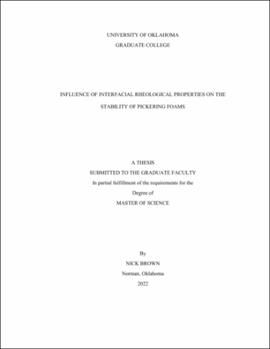| dc.contributor.advisor | Razavi, Sepideh | |
| dc.contributor.author | Brown, Nicholas | |
| dc.date.accessioned | 2022-08-16T14:32:50Z | |
| dc.date.available | 2022-08-16T14:32:50Z | |
| dc.date.issued | 2022-07 | |
| dc.identifier.uri | https://hdl.handle.net/11244/336465 | |
| dc.description.abstract | This work is aimed at gaining a fundamental understanding of the role of interfacial
phenomena in foam stability. We have investigated the properties of Pickering foams,
stabilized with fumed and spherical colloidal silica nanoparticles, and studied the impacts
of particle attributes on the resulting properties such as bubble microstructure, foam liquid
content, and foam half – life. We have examined the microstructure of analogue particle –
laden interfaces and probed their response to applied deformations via both interfacial
dilatational and shear rheology measurements. While the overall foam heights and
microstructure remain similar for both particle types used, differences are observed in their
interfacial shear and dilatational rheological measurements. Foams stabilized with fumed
silica particles are able to resist liquid drainage to a higher degree, as captured by a
plateaued reduced osmotic pressure over time, whereas the reduced osmotic pressure for
the spherical particle – stabilized foams increased slowly over time. With regards to
rheology, the interfacial network formed by spherical silica particle had slightly larger
values of elastic moduli (𝐸’) than the fumed silica network. However, interfaces coated
with fumed silica particles, undergoing dilational deformations, retained a particle network
over a broader range of dilational strain compared to spherical particles. In shear mode, the
interfacial networks formed by the spherical particles have higher storage moduli (𝐺’)
compared to those obtained from fumed particles, whereas the critical shear strain
corresponding to the yield point is larger for the fumed particle networks. Our findings
demonstrate that while both fumed and spherical silica particles are able to stabilize the
air/water interface and make long – lasting foams, the resulting Pickering foams are
markedly different with respect to their network properties and resistance to various
destabilization mechanisms. | en_US |
| dc.language | en_US | en_US |
| dc.rights | Attribution-ShareAlike 4.0 International | * |
| dc.rights.uri | https://creativecommons.org/licenses/by-sa/4.0/ | * |
| dc.subject | Particle-stabilized foams | en_US |
| dc.subject | Interfacial Rheology | en_US |
| dc.subject | Destabilization Mechanisms | en_US |
| dc.subject | Fluid Interfaces | en_US |
| dc.title | Influence of Interfacial Rheological Properties on the Stability of Pickering Foams | en_US |
| dc.contributor.committeeMember | Harwell, Jeffrey | |
| dc.contributor.committeeMember | Bui, Ngoc | |
| dc.date.manuscript | 2022-07 | |
| dc.thesis.degree | Master of Science | en_US |
| ou.group | Gallogly College of Engineering::School of Chemical, Biological and Materials Engineering | en_US |
| shareok.orcid | 0000-0002-9483-8220 | en_US |

